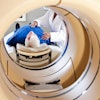
Multimodality imaging, including functional MRI (fMRI), PET, and SPECT, will be used to understand the benefits of yoga for cancer patients as part of a collaborative research initiative between researchers in the U.S. and India.
The University of Texas M. D. Anderson Cancer Center in Houston has joined forces with the Swami Vivekananda Yoga Anusandhana Samsthana Research Foundation (VYASA) in Bangalore to identify brain areas that are affected by yoga practices and meditation-based programs, and also confirm the results of earlier studies that have pinpointed changes in certain regions of the brain.
"By expanding into brain imaging-based outcomes, we will be better able to understand the effects of yoga centrally that goes beyond even assessing aspects of immune and hormonal function," Dr. Lorenzo Cohen told AuntMinnie.com. Cohen is director of the Integrative Medicine Program at M. D. Anderson and an associate professor in the departments of behavioral science and palliative care and rehabilitation medicine.
In recent research, Cohen and his colleagues illustrated that yoga improves sleep quality in lymphoma patients who practiced Tibetan yoga for seven weeks. They reported that patients went to sleep faster, slept longer, had better overall sleep quality, and required less sleep medication, compared with a control group of patients with lymphoma who did not use yoga (Cancer, May 2004, Vol. 100:10, pp. 2253-2260).
While changes observed in immune and hormone function could be transient, especially if participants did not continue to practice yoga, imaging may show profound changes in brain function that could have a lasting effect and many residual benefits, Cohen explained.
"Our imaging research is currently in its infancy, but this is an area where we wish to expand in the near future," Cohen said, adding that most of the imaging work would be done at M. D. Anderson, but some would also be done in Bangalore.
VYASA has 45 research papers on yoga therapy and yoga applications to its credit in various national and international journals. It has conducted fMRI studies into the benefits of meditation with the Institute of Nuclear Medicine and Allied Sciences in Delhi, India, and also has several ongoing studies with Indian cancer institutions. Overseas research collaborations have also been done in the U.K. and with the University of California, San Francisco.
The use of imaging in research, however, has been constrained by the high costs. "Imaging studies are very expensive. It is very difficult and near impossible to get funding for such projects," Raghavendra Rao, Ph.D., a senior scientist at VYASA, told AuntMinnie.com. Rao's doctoral thesis is on the efficacy of yoga in stage II and stage III breast cancer patients undergoing conventional treatment through surgery, chemotherapy, and radiotherapy.
Rao is also co-investigator in the breast cancer project at M. D. Anderson, where researchers from both institutions are studying the effects of yoga on breast cancer patients undergoing radiation treatment. Cohen is lead researcher for the project that will evaluate if yoga reduces patient fatigue and sleep disturbances, while improving overall quality of life, mental health, stress hormone levels, and aspects of immune function.
"Imaging studies are quite expensive, so they are typically done on fewer participants than other outcomes," Cohen said. Yet he stressed the importance of evaluating yoga at multiple levels, apart from biological measures and self-reporting by patients.
"The work to date that shows the effects of meditation on brain structures suggests that profound changes can take place that help us to better understand the benefits of these mind/body type of interventions in terms of emotional regulation and emotional processing," he said.
The imaging projects to be done by the research collaboration are still under consideration, but the work is most likely to start with healthy populations and long-time yoga practitioners. Researchers expect the frontal lobe of the brain, the most evolved part of the brain, to show activity during meditation.
"PET studies have shown frontal lobe activation during meditation practice. Both conceptually and based evidence from published literature, we expect frontal lobe activation," said Naveen K.V., Ph.D., a senior scientist at VYASA who has worked on the standardization of fMRI protocols for meditation with the department of radiology at the University of Florida in Gainesville.
"Even today we don't have the ideal software to visualize the frontal lobe of the brain with susceptibility artifacts contaminating signals from the frontal lobe," Naveen said about fMRI studies on meditation. He is co-author of an fMRI paper on frontal lobe activation during meditation (Indian Journal of Physiology and Pharmacology, 2000, Vol. 44:5, pp. 34).
Naveen said there was a need for more cross-cultural studies to bolster yoga's benefits regardless of ethnicity or geography.
Most recently, VYASA researchers found that a yoga practice during the antenatal period of pregnancy can improve fetal outcomes by reducing the chance of premature birth and supporting a healthy birth weight. The group also found that pregnancy-induced hypertension rates were lower in women who practice yogic postures, breathing exercises, and meditation (Journal of Alternative and Complementary Medicine, April 2005, Vol. 11:2, pp. 237-244).
By N. Shivapriya
AuntMinnie.com contributing writer
June 3, 2005
Above, a statute of spiritual leader Swami Vivekananda on the grounds of the VYASA ashram. Image courtesy of VYASA.
Related Reading
Wealthy new lab aims to capture dreams, literally, October 14, 2004
Illuminating the mind: Imaging explores the mysteries of meditation, September 11, 2003
Strike a pose: PET sheds light on benefits of yoga, December 31, 2002
Copyright © 2005 AuntMinnie.com



















